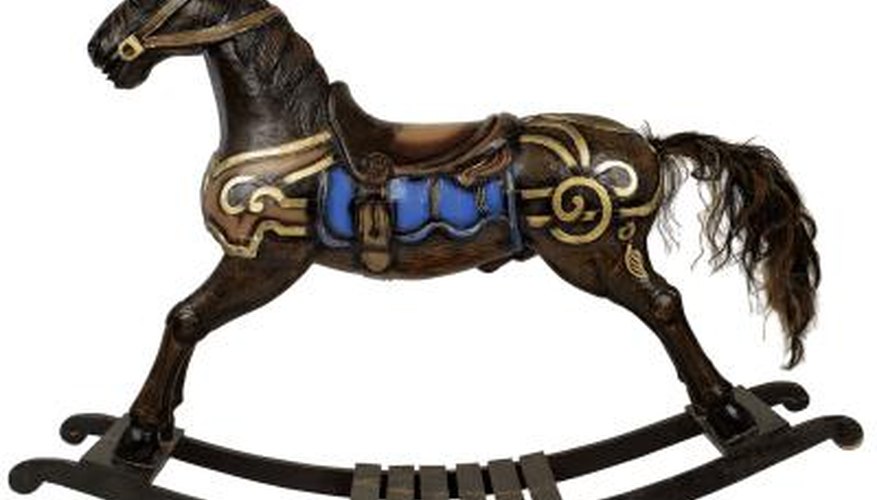For centuries, horses have been made into children's toys, and examples have been found dating from 400BC, according to the Legends Rocking Horses website. The modern rocking horse became popular in Britain in Victorian times and quickly spread across the globe. The original horses were on curved wooden rockers, but many modern toys use the safety stand, invented in the United States in 1880. Rocking horses are traditionally painted in dapple grey, but other colour schemes are popular, including realistic colour schemes that mimic natural horse colours.
Traditional Color Schemes
Dapple grey has been a traditional favourite for rocking horses ever since Queen Victoria selected that colour from the factory in the 19th century, the YesterdayTomorrow website reports. The horses are painted grey or white, and then dapples are added in darker grey or black. These can take the form of black spots, or darker areas painted over the top of the original colour with circles of the paler colour showing through. The dapples should be concentrated on the neck, shoulder and rump to mimic the patterning of a real horse.
- Dapple grey has been a traditional favourite for rocking horses ever since Queen Victoria selected that colour from the factory in the 19th century, the YesterdayTomorrow website reports.
- The dapples should be concentrated on the neck, shoulder and rump to mimic the patterning of a real horse.
Realistic Color Schemes
Rocking horses can also be painted to look like real horses. To give a modern twist on the original theme, horses are painted pinto (white with black or brown patches), Appaloosa (spotted), chestnut, bay, black or palomino. The addition of white markings such as stars on the face and socks or stockings on the legs make the horses look more realistic. You could also try copying the colour and markings of a real horse.
- Rocking horses can also be painted to look like real horses.
- The addition of white markings such as stars on the face and socks or stockings on the legs make the horses look more realistic.
Children's Color Schemes
Rocking horses designed for very young children are often more basic. They are normally made with no detachable parts and include a seat and handles set into the neck of the horse. Such horses are more toys than realistic models, and are often painted in bright primary colours with the addition of stylised flowers, stars or cartoon characters painted onto the rump. Rocking horses for girls are often pink with the bridle and seat picked out in a different colour. For boys try a camouflage theme or painting the horse with plain varnish.
- Rocking horses designed for very young children are often more basic.
- Rocking horses for girls are often pink with the bridle and seat picked out in a different colour.
Fantasy Color Schemes
Horses designed as collectors' items rather than toys can have elaborate patterning. Try painting the horse with the Stars and Stripes, using masking tape to keep edges sharp or paint the base colour dark blue and add gold stars. Fantasy themes work, too. Add a carved wooden horn and paint the coat white to turn your horse into a unicorn or use gauze wings stuck in front of the saddle to create a fairy horse. To create a mermaid horse, paint a base colour of green or blue and then add rows of scales in iridescent paint. You can also try recreating an old-fashioned carousel horse in white and gold.
- Horses designed as collectors' items rather than toys can have elaborate patterning.
- Try painting the horse with the Stars and Stripes, using masking tape to keep edges sharp or paint the base colour dark blue and add gold stars.
